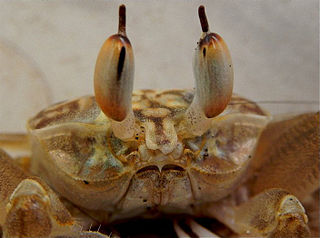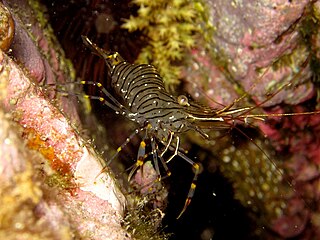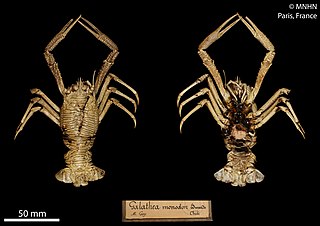 W
WAllopetrolisthes spinifrons is a species of porcelain crab. It displays "hypercarcinisation", whereby the resemblance to a true crab is enhanced by sexual dimorphism of the abdomen. It lives along the Pacific coast of Peru and Chile, as a symbiont of a sea anemone.
 W
WAlope is a genus of shrimp in the family Hippolytidae, comprising two species:Alope orientalis is widely distributed across the Indo-West Pacific. Alope spinifrons is endemic to New Zealand, and is found throughout that country's coasts.
 W
WThe American lobster is a species of lobster found on the Atlantic coast of North America, chiefly from Labrador to New Jersey. It is also known as Atlantic lobster, Canadian lobster, true lobster, northern lobster, Canadian Reds, or Maine lobster. It can reach a body length of 64 cm (25 in), and a mass of over 20 kilograms (44 lb), making it not only the heaviest crustacean in the world, but also the heaviest of all living arthropod species. Its closest relative is the European lobster Homarus gammarus, which can be distinguished by its coloration and the lack of spines on the underside of the rostrum. American lobsters are usually bluish green to brown with red spines, but several color variations have been observed.
 W
WAratus pisonii, commonly known as the mangrove tree crab, is a species of crab which lives in mangrove trees in tropical and subtropical parts of the Americas, from Florida to Brazil on the Atlantic coast, and from Nicaragua to Peru on the Pacific coast. It feeds mostly on the leaves of the mangroves, but is an omnivore, and prefers animal matter when possible. A. pisonii is the only species in the monotypic genus Aratus. The specific epithet pisonii commemorates the Dutch naturalist Willem Piso who travelled in Brazil in 1638 with Georg Marggraf.
 W
WAustruca annulipes is a species of fiddler crab found along the coastline from South Africa to Somalia, Madagascar, India, China, Indonesia, Malaysia and the Philippines.
 W
WAustruca perplexa is a species of fiddler crab. It is found from the Ryukyu Islands, Japan to India, throughout the Malay Archipelago, along eastern Australian coasts from Queensland to New South Wales, and in various Pacific islands, including Fiji, Tonga and Vanuatu.
 W
WCoenobita perlatus is a species of terrestrial hermit crab. It is known as the strawberry hermit crab because of its reddish-orange colours. It is a widespread scavenger across the Indo-Pacific, and is also traded to hobby aquarists.
 W
WCoenobita rugosus is a species of land hermit crab native to Indonesia, Australia and the east African coast to the south west Pacific.
 W
WCoenobita spinosus is one of the sixteen species of terrestrial hermit crabs.
 W
WEryma mandelslohi is a species of decapod crustacean that lived in Europe in the Jurassic of England. Fossils of the species have been found in the Oxford Clay.
 W
WGecarcoidea lalandii is a large species of terrestrial crab. It is dark purple in colour. It has long legs and short pincers. It is nocturnal, and spends most of the day hiding in burrows. Compared to the related G. natalis, G. lalandii is relatively widespread, being found in the Indo-Pacific from the Andaman Islands and eastwards. Adults mainly occur in forest, but can sometimes be found in more open habitats. When carrying eggs, females migrate to the coast, where they release the eggs in the tidal zone. Small adults sometimes fall prey to the crab Geograpsus crinipes.
 W
WGeograpsus lividus is a species of crab in the family Grapsidae.
 W
WHeloecius cordiformis is a species of semiterrestrial crab found in mangrove swamps and mudflats along the east coast of Australia. Adults are around 25 mm (1 in) wide, with males being larger and having larger and more conspicuously coloured claws. The males wave their claws to communicate with other crabs, giving them their common name of semaphore crab. They can breathe both in air and under water, and feed at low tide on detritus in the sediment. H. cordiformis is the only species in the genus Heloecius and the family Heloeciidae.
 W
WHemigrapsus crenulatus, the hairy-handed crab or papaka huruhuru, is a marine crab of the family Varunidae, endemic to the New Zealand coast, although a taxon in Chile may be conspecific.
 W
WHemigrapsus sexdentatus, known as the common rock crab, is a large-eyed marine crab of the family Varunidae, endemic to the coasts of New Zealand. However, it is not found in the Chatham Islands or the southern islands. It can grow to around 45 millimetres (1.8 in) (female) or 55 millimetres (2.2 in) (male) shell width.
 W
WThe Indian prawn, is one of the major commercial prawn species of the world. It is found in the Indo-West Pacific from eastern and south-eastern Africa, through India, Malaysia and Indonesia to southern China and northern Australia. Adult shrimp grow to a length of about 22 cm (9 in) and live on the seabed to depths of about 90 m (300 ft). The early developmental stages take place in the sea before the larvae move into estuaries. They return to the sea as sub-adults.
 W
WJasus lalandii is a species of spiny lobster found off the coast of Southern Africa. It is not known whom the specific epithet lalandii commemorates, although it may the French naturalist and taxonomer Pierre Antoine Delalande.
 W
WJohngarthia lagostoma is a species of terrestrial crab that lives on Ascension Island and three other islands in the South Atlantic. It grows to a carapace width of 110 mm (4.3 in) on Ascension Island, where it is the largest native land animal. It exists in two distinct colour morphs, one yellow and one purple, with few intermediates. The yellow morph dominates on Ascension Island, while the purple morph is more frequent on Rocas Atoll. The species differs from other Johngarthia species by the form of the third maxilliped.
 W
WMacrobrachium lamarrei commonly known as the Indian whisker shrimp, kuncho river prawn is a nocturnal species of freshwater shrimp found Biratnagar, Nepal.
 W
WNeopetrolisthes maculatus is a species of porcelain crab from the Indo-Pacific region. It is a small, colourful crustacean with a porcelain-like shell. This porcelain crab is usually found within the stinging tentacles of a number of sea anemone species.
 W
WOcypode brevicornis is a species of ghost crab native to the Indian Ocean, from the Gulf of Oman to the Nicobar Islands. They are relatively large ghost crabs with a somewhat trapezoidal body. The carapace reaches a length of 41 mm (1.6 in) and a width of 50 mm (2.0 in). They are a mottled brown to yellow in coloration. Like other ghost crabs, one of their claws is much larger than the other. Their eyestalks are large and elongated, tipped with prolongations at the tip known as styles. They are common inhabitants of open sandy beaches, living in burrows in the intertidal zone.
 W
WOcypode fabricii is a species of ghost crabs endemic to the coast of northern and western Australia, from Darwin to Shark Bay. They are medium-sized ghost crabs with a squarish body. The carapace reaches a length of 38 mm (1.5 in) and a width of 40 mm (1.6 in). Like other ghost crabs, one of their claws is much larger than the other. They live in burrows in the intertidal zones of the muddy to sandy beaches of mangrove forests.
 W
WPalaemon adspersus, commonly called Baltic prawn, is a species of shrimp that is frequent in the Baltic Sea, and is the subject of fisheries in Denmark. It is up to 70 mm (2.8 in) long, and lives in Zostera beds.
 W
WPalaemon affinis is a species of shrimp of the family Palaemonidae. Early authors used the name Palaemon affinis for specimens now known to belong to a variety of species, but P. affinis is now known to be endemic to the waters of New Zealand.
 W
WPalaemon elegans sometimes known by the common name rockpool shrimp, is a species of shrimp of the family Palaemonidae. It is found in the Atlantic, the Baltic, the Mediterranean, the Black Sea, the Caspian Sea and the Azores. It is similar to three other members of the genus Palaemon: Palaemon serratus, Palaemon longirostris and Palaemon adspersus, and has displaced or replaced populations of Palaemon adspersus in some locations. It is considered an invasive species in parts of the United States.
 W
WPalaemon longirostris is a species of shrimp of the family Palaemonidae. It is considered an invasive species in the Black Sea.
 W
WParaleptuca chlorophthalmus, is a common fiddler crab found in the mangroves of East Africa, from Somalia to South Africa, as well as Madagascar and Mauritius. Marsh fiddlers dig burrows in the muddy or sandy banks of salt marshes, which they use to protect themselves from predators, high tide and extreme temperatures. They feed by filtering detritus out of mud, and defend their burrows against other fiddler crabs. Paraleptuca chlorophthalmus is characterised by its red pereiopods and blue and black markings on its carapace.
 W
WPetrolisthes elongatus, known as the New Zealand half crab, elongated porcelain crab, blue half crab, blue false crab or simply as the half crab or false crab, is a species of porcelain crab native to New Zealand.
 W
WPleuroncodes monodon, sometimes called the red squat lobster, is a species of squat lobster from the south-eastern Pacific Ocean, where it is the subject of commercial fishery alongside the species Cervimunida johni.
 W
WPotamonautes perlatus, the Cape river crab, is a species of crab in the family Potamonautidae.
 W
WThe salmon louse is a species of copepod in the genus Lepeophtheirus. It is a sea louse, a parasite living mostly on salmon, particularly on Pacific and Atlantic salmon and sea trout, but is also sometimes found on the three-spined stickleback. It feeds on the mucus, skin and blood of the fish. Once detached, they can be blown by wind across the surface of the sea, like plankton. When they encounter a suitable marine fish host, they adhere themselves to the skin, fins, or gills of the fish, and feed on the mucus or skin. Sea lice only affect fish and are not harmful to humans.
 W
WScyllarides squammosus is a species of slipper lobster known as the 'blunt slipper lobster. It is found throughout the Indo-West Pacific region. Specifically its range is from Australia, Japan, Hawaii, Melanesia, New Caledonia to East Africa. Scyllarides squammosus has been found at depths from 7.5 m to 71 m.